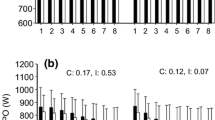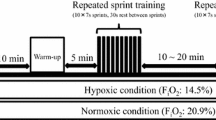Abstract
Purpose
This study investigated the effects of repeated-sprint (RS) training in hypoxia induced by voluntary hypoventilation at low lung volume (RSH-VHL) on physiological adaptations, RS ability (RSA) and anaerobic performance.
Methods
Over a 3-week period, eighteen well-trained cyclists completed six RS sessions in cycling either with RSH-VHL or with normal conditions (RSN). Before (Pre) and after (Post) the training period, the subjects performed an RSA test (10 × 6-s all-out cycling sprints) during which oxygen uptake \(\left( {{\dot{\text{V}}\text{O}}_{2} } \right)\) and the change in both muscle deoxyhaemoglobin (Δ[HHb]) and total haemoglobin (Δ[THb]) were measured. A 30-s Wingate test was also performed and maximal blood lactate concentration ([La]max) was assessed.
Results
At Post compared to Pre, the mean power output during both the RSA and the Wingate tests was improved in RSH-VHL (846 ± 98 vs 911 ± 117 W and 723 ± 112 vs 768 ± 123 W, p < 0.05) but not in RSN (834 ± 52 vs 852 ± 69 W, p = 0.2; 710 ± 63 vs 713 ± 72 W, p = 0.68). The average \({\dot{{\text{V}}}{{\text{O}}}}_{2}\) recorded during the RSA test was significantly higher in RSH-VHL at Post but did not change in RSN. No change occurred for Δ[THb] whereas Δ[HHb] increased to the same extent in both groups. [Lamax] after the Wingate test was higher in RSH-VHL at Post (13.9 ± 2.8 vs 16.1 ± 3.2 mmol L−1, p < 0.01) and tended to decrease in RSN (p = 0.1).
Conclusions
This study showed that RSH-VHL could bring benefits to both RSA and anaerobic performance through increases in oxygen delivery and glycolytic contribution. On the other hand, no additional effect was observed for the indices of muscle blood volume and O2 extraction.




Similar content being viewed by others
Abbreviations
- [HHb]:
-
Muscle concentrations of deoxyhaemoglobin
- [La]:
-
Blood lactate concentration
- \([{\rm La}]_{\max}\) :
-
Maximal blood lactate concentration
- \(\left[ {{\text{O}}_{{ 2 {}}} {\text{Hb}}} \right]\) :
-
Muscle concentrations of oxyhaemoglobin
- [THb]:
-
Total haemoglobin
- HR:
-
Heart rate
- MPO:
-
Mean power output
- NIRS:
-
Near-infrared spectroscopy
- \({\text{O}}_{{ 2 {}}}\) :
-
Oxygen
- PPO:
-
Peak power output
- Reoxy[HHb]:
-
Amplitude variation between the peak and nadir [HHb]
- Reoxy[THb]:
-
Amplitude variation between the peak and nadir [THb]
- RPE:
-
Rating of perceived exertion
- RSA:
-
Repeated sprint ability
- RSE:
-
Repeated-sprint exercise
- RSH:
-
Repeated sprints in hypoxia
- RSH-VHL:
-
Repeated sprints in hypoxia induced by voluntary hypoventilation at low lung volume
- RSN:
-
Repeated sprints in normoxia
- \({\text{SpO}}_{{ 2 {}}}\) :
-
Arterial oxygen saturation
- VHL:
-
Voluntary hypoventilation at low lung volume
- \({\dot{\text{V}}\text{O}}_{2}\) :
-
Oxygen uptake
- \({\dot{\text{V}}\text{O}}_{2} /{\text{HR}}\) :
-
Oxygen pulse
References
Amann M, Romer LM, Subudhi AW, Pegelow DF, Dempsey JA (2007) Severity of arterial hypoxaemia affects the relative contributions of peripheral muscle fatigue to exercise performance in healthy humans. J Physiol 581:389–403
Billaut F, Buchheit M (2013) Repeated-sprint performance and vastus lateralis oxygenation: effect of limited O2 availability. Scand J Med Sci Sports 23:e185–193
Bishop D, Girard O, Mendez-Villanueva A (2011) Repeated-sprint ability—part II: recommendations for training. Sports Med 41:741–756 (Review).
Boushel R, Piantadosi CA (2000) Near-infrared spectroscopy for monitoring muscle oxygenation. Acta Physiol Scand 168:615–622
Brocherie F, Girard O, Faiss R, Millet GP (2017) Effects of repeated-sprint training in hypoxia on sea-level performance: a meta-analysis. Sports Med 47:1651–1660 (Review).
Carling C (2013) Interpreting physical performance in professional soccer match-play: should we be more pragmatic in our approach? Sports Med 43:655–663
Casey DP, Joyner MJ (2012) Compensatory vasodilatation during hypoxic exercise: mechanisms responsible for matching oxygen supply to demand. J Physiol 590(Pt 24):6321–6326
Casey DP, Curry TB, Wilkins BW, Joyner MJ (2011) Nitric oxide-mediated vasodilation becomes independent of beta-adrenergic receptor activation with increased intensity of hypoxic exercise. J Appl Physiol 110:687–694
De Blasi RA, Cope M, Elwell C, Safoue F, Ferrari M (1993) Noninvasive measurement of human forearm oxygen consumption by near infrared spectroscopy. Eur J Appl Physiol Occup Physiol 67:20–25
Faiss R, Léger B, Vesin JM, Fournier PE, Eggel Y, Dériaz O, Millet GP (2013a) Significant molecular and systemic adaptations after repeated sprint training in hypoxia. PLoS 8:e56522
Faiss R, Girard O, Millet GP (2013b) Advancing hypoxic training in team sports: from intermittent hypoxic training to repeated sprint training in hypoxia. Br J Sports Med 47(Suppl 1):i45–i50
Faiss R, Willis S, Born DP, Sperlich B, Vesin JM, Holmberg HC, Millet GP (2015) Repeated double-poling sprint training in hypoxia by competitive cross-country skiers. Med Sci Sports Exerc 47:809–817
Fernandez M, Burns K, Calhoun B, George S, Martin B, Weaver C (2007) Evaluation of a new pulse oximeter sensor. Am J Crit Care 16:146–152
Fornasier-Santos C, Millet GP, Woorons X (2018) Repeated-sprint training in hypoxia induced by voluntary hypoventilation improves running repeated-sprint ability in rugby players. Eur J Sport Sci 18:504–512
Foster C, Florhaug JA, Franklin J, Gottschall L, Hrovatin LA, Parker S, Doleshal P, Dodge C (2001) A new approach to monitoring exercise training. J Strength Cond Res 15:109–115
Girard O, Mendez-Villanueva A, Bishop D (2011) Repeated-sprint ability—part I: factors contributing to fatigue. Sports Med 41:673–694 (Review).
Glaister M, Howatson G, Pattison JR, McInnes G (2008) The reliability and validity of fatigue measures during multiple-sprint work: an issue revisited. J Strength Cond Res 22:1597–1601
Grassi B, Pogliaghi S, Rampichini S, Quaresima V, Ferrari M, Marconi C, Cerretelli P (2003) Muscle oxygenation and pulmonary gas exchange kinetics during cycling exercise on transitions in humans. J Appl Physiol 95:149–158
Haseler LJ, Hogan MC, Richardson RS (1999) Skeletal muscle phosphocreatine recovery in exercise-trained humans is dependent on O2 availability. J Appl Physiol 86:2013–2018
McGawley K, Bishop D (2008) Anaerobic and aerobic contribution to two, 5 × 6-s repeated-sprint bouts. Coach Sport Sci J 3:52
Racinais S, Bishop D, Denis R, Lattier G, Mendez-Villaneuva A, Perrey S (2007) Muscle deoxygenation and neural drive to the muscle during repeated sprint cycling. Med Sci Sports Exerc 39:268–274
Rodriguez RF, Townsend NE, Aughey RJ, Billaut F (2018) Influence of averaging method on muscle deoxygenation interpretation during repeated-sprint exercise. Scand J Med Sci Sports 28:2263–2271
Trincat L, Woorons X, Millet GP (2017) Repeated sprint training in hypoxia induced by voluntary hypoventilation in swimming. Int J Sports Physiol Perform 2:329–335
Wainwright B, Cooke CB, O'Hara JP (2017) The validity and reliability of a sample of 10 Wattbike cycle ergometers. J Sports Sci 35:1451–1458
Whipp BJ, Higgenbotham MB, Cobb FC (1996) Estimating exercise stroke volume from asymptotic oxygen pulse in humans. J Appl Physiol 81:2674–2679
Woorons X (2014) Hypoventilation training, push your limits!. Arpeh, Lille
Woorons X, Mollard P, Pichon A, Duvallet A, Richalet J-P, Lamberto C (2008) Effects of a 4-week training with voluntary hypoventilation carried out at low pulmonary volumes. Respir Physiol Neurobiol 160:123–130
Woorons X, Bourdillon N, Vandewalle H, Lamberto C, Mollard P, Richalet JP, Pichon A (2010) Exercise with hypoventilation induces lower muscle oxygenation and higher blood lactate concentration: role of hypoxia and hypercapnia. Eur J Appl Physiol 110:367–377
Woorons X, Bourdillon N, Lamberto C, Vandewalle H, Richalet JP, Mollard P, Pichon A (2011) Cardiovascular responses during hypoventilation at exercise. Int J Sports Med 32:438–445
Woorons X, Mucci P, Richalet JP, Pichon A (2016) Hypoventilation training at supramaximal intensity improves swimming performance. Med Sci Sports Exerc 48:119–128
Woorons X, Mucci P, Aucouturier J, Anthierens A, Millet GP (2017) Acute effects of repeated cycling sprints in hypoxia induced by voluntary hypoventilation. Eur J Appl Physiol 117:2433–2443
Woorons X, Dupuy O, Mucci P, Millet GP, Pichon A (2019) Cerebral and muscle oxygenation during repeated shuttle run sprints with hypoventilation. Int J Sports Med 40:376–384. https://doi.org/10.1055/a-0836-901110.1055/a-0836-9011 [Epub ahead of print]
Acknowledgements
We sincerely thank all the subjects who participated in this study for their efforts, time and dedication. We are also grateful to Adrien Combes for his assistance.
Funding
The authors declare that they received no funding for this work.
Author information
Authors and Affiliations
Contributions
XW and PM conceived and designed research and conducted the experiments. XW, GM and PM analysed data and interpreted the results of the experiments. XW wrote the manuscript. All authors edited, revised and approved the final version of the manuscript.
Corresponding author
Ethics declarations
Conflict of interest
The authors declare that they have no conflict of interest.
Additional information
Communicated by Susan Hopkins.
Publisher's Note
Springer Nature remains neutral with regard to jurisdictional claims in published maps and institutional affiliations.
Rights and permissions
About this article
Cite this article
Woorons, X., Millet, G.P. & Mucci, P. Physiological adaptations to repeated sprint training in hypoxia induced by voluntary hypoventilation at low lung volume. Eur J Appl Physiol 119, 1959–1970 (2019). https://doi.org/10.1007/s00421-019-04184-9
Received:
Accepted:
Published:
Issue Date:
DOI: https://doi.org/10.1007/s00421-019-04184-9




